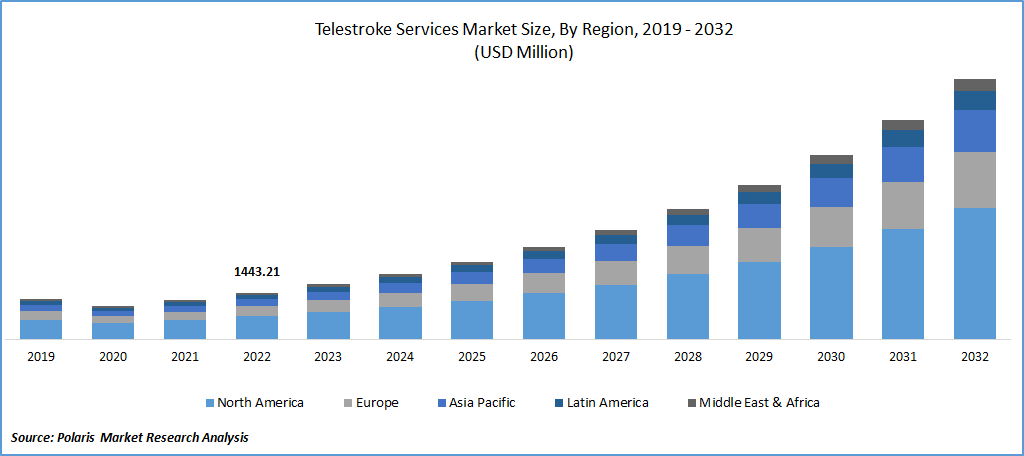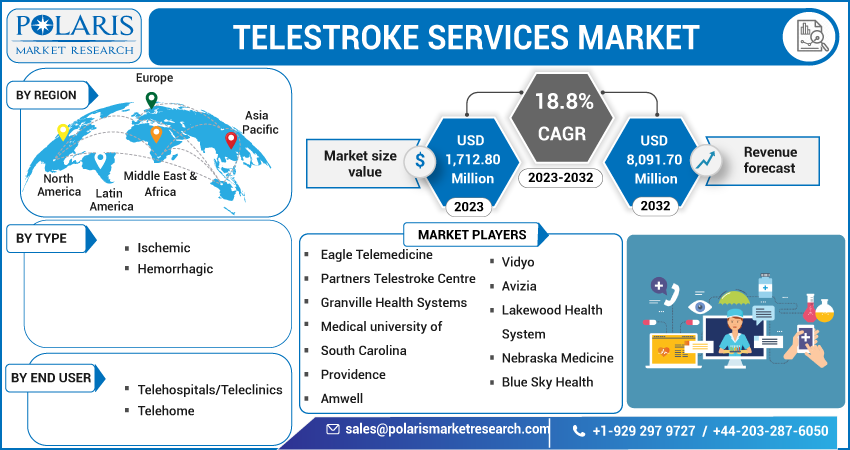
Telestroke Services Market Share, Size, Trends, Industry Analysis Report
By Type (Ischemic, Hemorrhagic); By End User; By Region; Segment Forecast, 2023 - 2032
- Published Date:Jul-2023
- Pages: 112
- Format: PDF
- Report ID: PM3526
- Base Year: 2022
- Historical Data: 2019-2021
Report Outlook
The global telestroke services market was valued at USD 1,443.21 million in 2022 and is expected to grow at a CAGR of 18.8% during the forecast period. The growing demand for telehealth is one of the key drivers of the market's growth. Telehealth services, which include telemedicine and tele-stroke services, allow patients to receive medical care remotely, using telecommunication technologies such as video conferencing and remote monitoring. Amwell, a pioneer in telehealth nationwide, has revealed the findings of its annual Physician and Consumer Survey.

To Understand More About this Research: Request a Free Sample Report
Since COVID-19, scheduled visits have become more common across all specialties, whereas before that, most visits were for urgent care provided on demand. As more healthcare providers and patients recognize the benefits of tele-stroke services, they expect to see continued growth in this market in the coming years.
Industry Dynamics
Growth Drivers
Telemedicine and telehealth services are becoming increasingly popular, driven by cost savings, improved patient outcomes, and the need for remote care. Telestroke services are a natural extension of these trends. Telestroke services offer a way to deliver timely and effective stroke care to patients in remote or underserved areas. The study, published by JAMA Neurology, is the first to examine patient outcomes for telestroke across the US.
It demonstrates that patients who receive care at hospitals offering remote-based stroke assessment of teleservices who went to comparable hospitals without telestroke services. Telestroke services are powered by advanced technology, including videoconferencing, mobile devices, and remote monitoring systems. These technologies have become more affordable and accessible, making it easier to implement telestroke programs. This will further fuel the growth of the telestroke services market in the coming years.

For Specific Research Requirements, Request for a Customized Report
Report Segmentation
The market is primarily segmented based on type, end user and region.
|
By Type |
By End User |
By Region |
|
|
|
To Understand the Scope of this Report: Speak to Analyst
Ischemic segment is expected to witness fastest growth during forecast period
The Ischemic segment is expected to witness faster growth for the telestroke services market. Ischemic strokes are more common than hemorrhagic strokes. This means there is a larger potential patient population for telestroke services in the Ischemic segment. In addition, time is of the essence when it comes to treating ischemic strokes. Telestroke services can provide immediate access to specialists who can diagnose and treat ischemic strokes, improving outcomes and reducing the risk of disability and death.
Moreover, telestroke services can be particularly beneficial in rural areas or areas with limited access to stroke specialists. Telestroke services can connect patients in these areas with specialists who can provide timely and appropriate care, improving the quality of care and outcomes for patients with ischemic strokes. This will further fuel the growth of the market in the coming years.
Telehospitals/Teleclinics accounted for the largest market share in the study period
The Telehospitals/Teleclinics segment is expected to witness the largest market share for the forecast period. Telehospitals/Teleclinics can provide a more advanced and comprehensive level of care compared to Telehome services. They have access to specialized equipment, imaging, and medical professionals, which makes them better equipped to handle stroke emergencies. They have a higher level of clinical oversight, which can ensure that patients receive timely and appropriate care. This can be especially important in stroke emergencies, where time is of the essence, and prompt treatment can improve outcomes.
They also can handle more complex cases, including severe strokes. They can provide a higher level of care, such as neurosurgical intervention, which may not be possible in a Tele-home setting. In addition, they can provide greater access to stroke specialists, including neurologists and neurosurgeons, who may only be available in some areas. This can improve the quality of care for stroke patients, especially in areas with limited access to stroke specialists.
North America is expected to hold the highest growth in projected period
North America is projected to witness higher growth and a larger revenue share for the market in the coming years. This region has a highly developed healthcare infrastructure, which includes a well-trained workforce, advanced medical facilities, and robust regulatory frameworks. This makes it easier to implement and scale telestroke services in the region. The prevalence of stroke is high in North America, which has led to a greater demand for telestroke services.
According to the American Heart Association, stroke is the fifth leading cause of death in the United States, and someone in the United States has a stroke every 38 seconds. In the year 2020, there were 928,741 fatalities due to heart stroke. This region has seen a significant increase in the adoption of telemedicine and telehealth services in recent years, driven by factors such as the need for remote patient monitoring, the shortage of healthcare professionals in some areas, and the increasing use of mobile devices. This trend is expected to drive the growth of the telestroke services market in North America.
Europe is projected to witness significant growth in the market in the forecast period. This region has a high stroke burden, the second leading cause of death in the area after heart disease. This has led to a growing demand for telestroke services.
The growing incidence of strokes in Europe creates a significant opportunity for the telestroke services market to grow. As more healthcare providers and patients recognize the benefits of telestroke services, we can expect to see continued growth in this market in the coming years. Europe has seen a significant increase in the adoption of telemedicine and telehealth services in recent years, driven by factors such as the aging population, the shortage of healthcare professionals in some areas, and the need for cost-effective healthcare solutions. This trend is expected to drive the growth of the telestroke services market in Europe.
Competitive Insight
Some of the major players operating in the global market include Eagle Tele-medicine, Granville Health, Providence, Amwell, Vidyo, Avizia, Lakewood Health, and Nebraska Medicine
Recent Developments
In March 2023, Amwell, a pioneer in enabling digital healthcare, announced adding a cardio-metabolic program to its digital clinical programs through a partnership with DarioHealth.
In October 2022, American Heart Association started a 2-year initiative to improve the post-acute stroke service in Nebraska, & North Dakota to give all patients the best chance at living independently after a stroke.
Tele-stroke Services Market Report Scope
|
Report Attributes |
Details |
|
Market size value in 2023 |
USD 1,712.80 million |
|
Revenue forecast in 2032 |
USD 8,091.70 million |
|
CAGR |
18.8% from 2023 - 2032 |
|
Base year |
2022 |
|
Historical data |
2019 - 2021 |
|
Forecast period |
2023 - 2032 |
|
Quantitative units |
Revenue in USD million/billion and CAGR from 2023 to 2032 |
|
Segments covered |
By Type, By End User, By Region |
|
Regional scope |
North America, Europe, Asia Pacific, Latin America; Middle East & Africa |
|
Key companies |
Eagle Telemedicine, Partners Telestroke Centre, Granville Health Systems, Medical university of South Carolina, Providence, Amwell, Vidyo, Avizia, Lakewood Health System, Nebraska Medicine & Blue Sky Health. |
FAQ's
Telestroke Services Market Size Worth 8,091.70 Million By 2032.
Top market players in the Telestroke Services Market are Eagle Tele-medicine, Granville Health, Providence, Amwell, Vidyo, Avizia, Lakewood Health.
North America contribute notably towards the global Telestroke Services Market.
The global telestroke services market expected to grow at a CAGR of 18.8% during the forecast period.
The Telestroke Services Market report covering key are type, end user and region.
